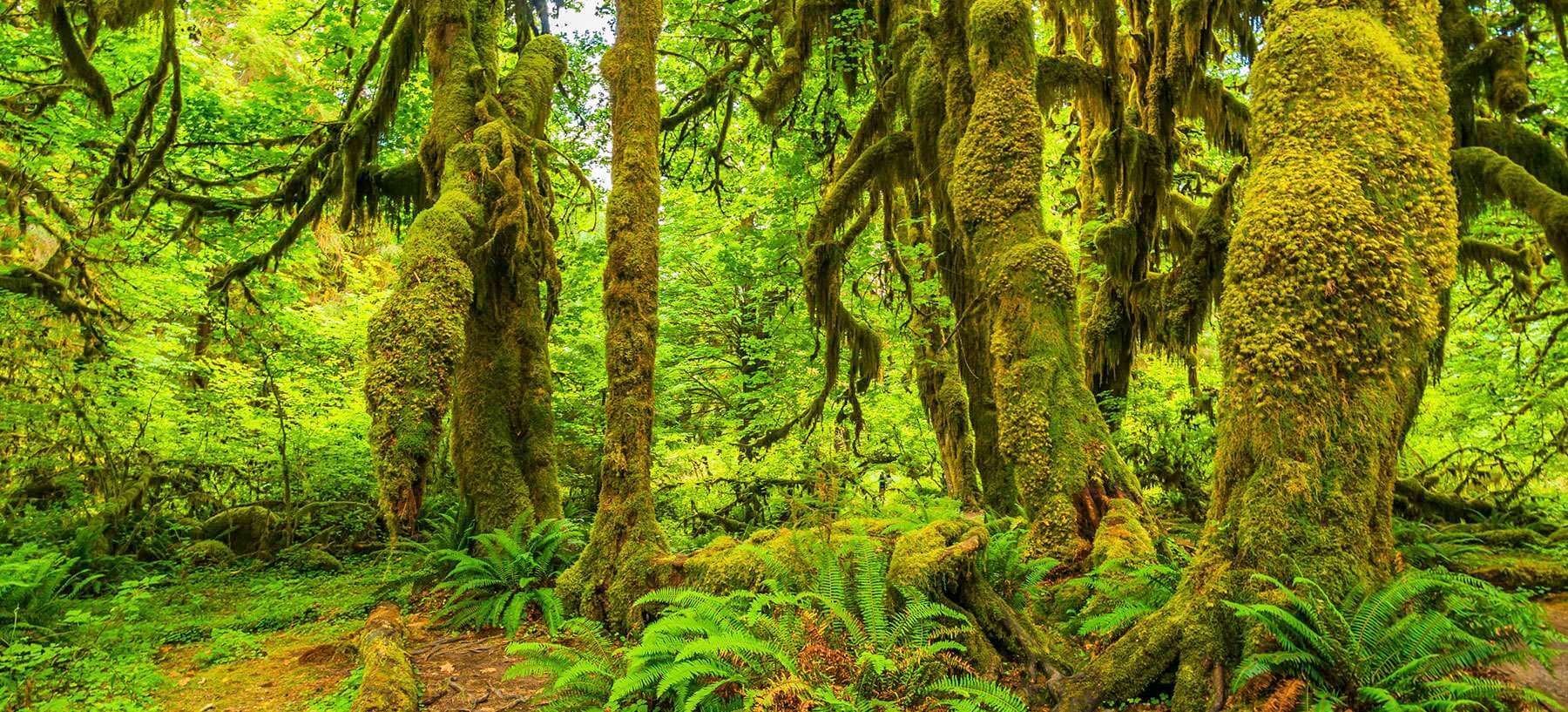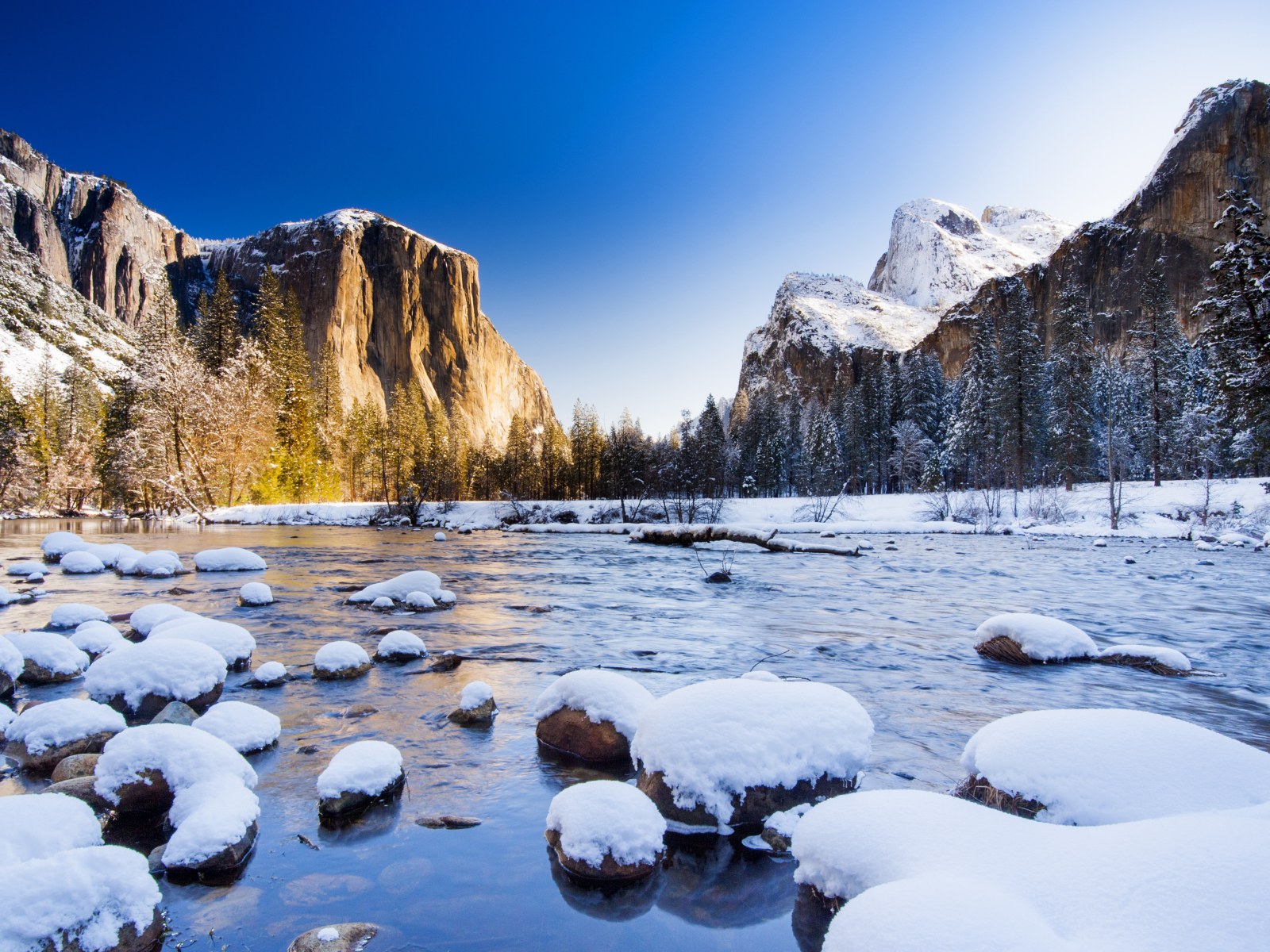Best Natural Attractions in Washington State: Olympic National Park
Washington State is one of the most scenic regions in the United States, known for its natural diversity. Everything from mountain peaks and dense forests to lakes, rivers and coastal areas can be found here. The rich nature of the state attracts outdoor enthusiasts, tourists and those seeking tranquility amidst natural beauty. One of the most impressive parts of this state is Olympic National Park, a unique place encompassing a variety of ecosystems and astonishing in its scale and diversity of landscapes.
Olympic National Park is a gem of Washington State that offers a unique opportunity to experience nature at its most scenic. Whether you love mountain hiking, walking through forests, or relaxing on the beach, this park caters to all needs. A move to Washington State can open up access to a plethora of natural attractions, and Olympic National Park is one place that is a must-see for everyone.
Olympic National Park is located on the Olympic Peninsula in western Washington State and covers an area of about 4,000 square kilometers. This park was created in 1938 and is a UNESCO World Heritage Site due to its biodiversity and picturesque landscapes. Three main natural areas can be found here: coastal areas, alpine mountains and temperate rainforests.

Coastal Zones
The coastal areas of Olympic National Park represent one of the wildest and most dramatic landscapes not only in Washington State, but in the entire country. The park’s coastline stretches more than 100 kilometers along the Pacific Ocean and is an amazing combination of unbridled nature, powerful waves, rugged cliffs, and dense forests that extend to the very edge of the water. This unique coastline makes the coastal areas of Olympic Park popular with tourists, photographers and outdoor enthusiasts.
1. Terrain and Coastal Features
The park’s coastal areas include wild beaches with unusual rock formations, sea stacks (cliffs rising from the ocean), scattered boulders, and large amounts of fins that come ashore after storms. Rock arches and sea grottoes, formed by thousands of years of wind and wave action, give the area a unique atmosphere. Many parts of the coastline are surrounded by dense coniferous forests, which makes this part of the park extremely picturesque.
One of the unique features of the coastline is its variability – the tides constantly change the appearance of the beaches. During low tides one can observe open areas of the seabed covered with algae, starfish, crabs and other representatives of marine fauna.
2. Popular places to visit
Olympic National Park offers many unique beaches and coastal areas that attract tourists with their beauty and unusual landscapes. Here are a few of them:
- Rialto Beach: This beach is known for its massive boulders and rocks, discarded fins, and powerful surf. It is one of the best places to walk along the ocean and watch seabirds.
- Calla Beach: This beach is surrounded by dense forests and is one of the most popular camping spots. You can also see sea stacks, which are tall rocky pillars rising out of the water.
- Third Beach: This is a more secluded spot, accessed by a trail through the forest. Here you can enjoy the tranquility and beauty of the wilderness away from major tourist areas.
3. Wildlife
The coastal areas of Olympic National Park are home to a rich diversity of fauna. Harbor seals, sea otters, and numerous species of seabirds such as cormorants, gulls, and petrels can be found here. Gray whales can sometimes be seen migrating along the coast during their annual migration between Alaska and Mexico.
Tides (ebb tides) offer incredible opportunities to study marine life in tide pools where starfish, anemones, crabs, and other marine life can be seen. These pools are located in small hollows in the cliffs and become miniature aquariums at low tide.
4. Outdoor activities
The coastal areas of the Olympic Park are ideal for a variety of outdoor activities. One of the most popular activities here is hiking along the coast. Trails leading to the beaches wind through dense forests and offer scenic views of the ocean. Some trails pass through rocky areas and require special care when traversing.
The coast also offers excellent camping opportunities. Camping along the coast allows you to enjoy the wildlife and spend the night to the sound of the surf. It is important to note that permits are required for camping in some areas and campers are advised to check in advance for information on available sites.

5. Practical tips for visiting the coast
To make a trip to the coastal areas of Olympic National Park as comfortable as possible, it is important to consider a few practical points:
- Watch the tides: While low tides open up new areas for hiking, high tides can make some trails impassable. Be sure to familiarize yourself with the tide schedule to avoid surprises.
- Weather Protection: The Olympic Park coastline can be windy and chilly, especially in the evening. Bring warm and waterproof clothing to stay comfortable in all conditions.
- Respect Nature: The park is a protected area, so it’s important to follow conservation rules, don’t leave trash, and don’t disturb the ecosystems of tide pools and beaches.
The coastal areas of Olympic National Park are the perfect place for wildlife enthusiasts and those seeking adventure amid incredible ocean scenery. With wild beaches, massive cliffs, and abundant marine life, this part of the park offers a unique experience for anyone looking to explore one of the most scenic and wild coastlines in Washington State.
Alpine mountains and lakes
The Olympic National Park offers its visitors a variety of natural landscapes, among which its alpine mountains and lakes occupy a special place. This region is a real find for those looking for spectacular mountain panoramas, crystal clear lakes and opportunities for outdoor activities.
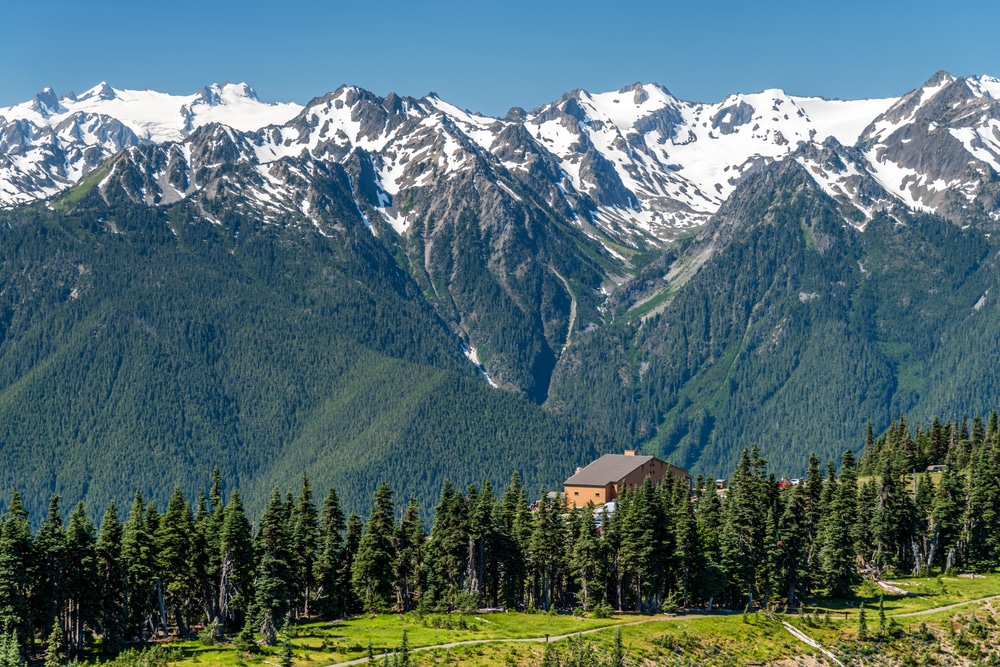
1. Olympic Mountains: majesty and uniqueness
The Olympic Mountains occupy the central part of the Olympic Peninsula and rise above its dense forests and coastal areas. These mountains were formed about 30 million years ago by tectonic processes, and today they offer incredible views of the surrounding forests and ocean.
The highest point in the park is Mount Olympus, reaching a height of 2,428 meters. This iconic peak attracts climbers and hikers, offering a variety of routes, from easy walks to challenging climbs for experienced climbers.
The peculiarity of the Olympic Mountains is their contrasts: in the lower parts of the mountains you can find dense coniferous forests, passing into subalpine meadows, which in summer are covered with colorful wildflowers. Higher up, glaciers and snowfields begin, which adorn these peaks all year round, creating stark and impressive landscapes.
2. Popular trails and routes
- Hurricane Ridge: One of the most popular and accessible sections of the park’s alpine area. Here you can enjoy spectacular views of mountains, alpine meadows, and glaciers. This area attracts visitors in both summer and winter when skiing and snowboarding are available.
- Sol Duc Falls Trail: This trail passes through scenic forests and leads to the magnificent Sol Duc Falls, surrounded by lush greenery and wildlife. This is a great place for those looking for an easy and scenic hike with a chance to see the splendor of alpine scenery.
- Mount Angeles: A route for more experienced hikers that offers stunning views of the entire Olympic Peninsula. Panoramic views of mountains, forests, and the Pacific Ocean can be seen from the summit.
3. Olympic Park Lakes
The mountainous areas of the Olympic National Park are also home to several picturesque lakes, each with its own unique atmosphere and attracting tourists with its crystal clear waters and surroundings.
- Lake Crescent: One of the largest and most beautiful lakes in the park, it is known for its deep clear waters that play with shades of blue and green. The lake is surrounded by mountains, creating a stunning backdrop for walks, picnics and water activities. In the summertime, you can rent kayaks and enjoy water activities or just relax on the shore.
- Cushman Lake: Another popular tourist destination located at the foot of the mountains. Cushman Lake offers excellent swimming, fishing and camping opportunities. Its clear waters and picturesque scenery make it a great place for families to relax and enjoy nature.
- Sol Dak Lake: Located near the popular Sol Dak Falls, this lake is a quiet and peaceful place surrounded by dense forests. Tourists can often be found here hiking or enjoying a secluded fishing trip.
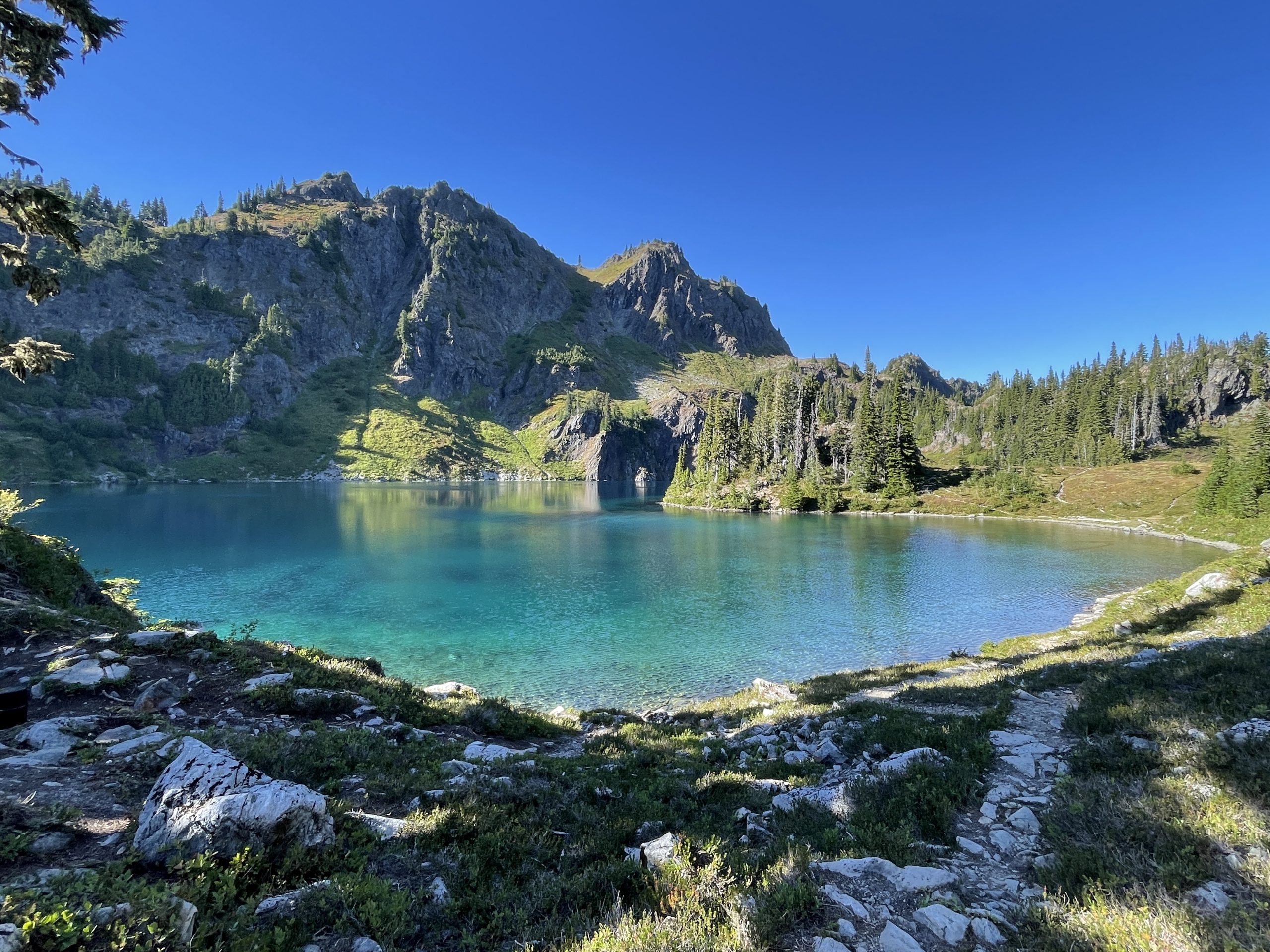
4. Glaciers
One of the remarkable features of the alpine zone of the Olympic National Park are its glaciers. The most famous of these is the Blue-Glacier Glacier, located on the slopes of Mount Olympus. This glacier covers an area of more than 4 square kilometers and is the source of several rivers and waterfalls in the park.
Glaciers not only beautify the mountain scenery, but also play an important role in maintaining the ecosystem of the region. They feed rivers and lakes, providing water for flora and fauna even during the dry summer months. For tourists interested in glaciers, there are special routes and excursions that allow them to get closer to these majestic natural objects and admire their scale.
5. Wildlife
The Alpine mountains and lakes of the Olympic Park are home to many species of animals and birds. Species such as black-tailed deer, bears, mountain goats and various bird species including eagles and hawks can be found here. In the summer, alpine meadows become home to numerous species of butterflies and other insects.
It is also important to remember that this is a wilderness area and tourists are advised to take safety precautions, especially when encountering bears and other large animals.

6. Tips for visiting alpine areas and lakes
To make your visit to the alpine areas of the Olympic Park enjoyable and safe, it is important to keep a few tips in mind:
- Proper outfit: Alpine areas can have harsh and unpredictable weather, even in summer. Bring warm clothing, a waterproof jacket and suitable mountain hiking shoes.
- Plan your route in advance: Some trails can be challenging and require physical fitness. Familiarize yourself with maps and trail information in advance to choose the most suitable ones for you.
- Protecting nature: Be considerate of the environment, do not leave litter or disturb the natural balance. The park is a protected area and it is important to follow all visiting rules to preserve its unique ecosystems.
The Alpine mountains and lakes of the Olympic National Park are a real treasure for those who love nature and outdoor activities. Magnificent landscapes, crystal clear lakes and a variety of flora and fauna make this place a must-visit. Whether you plan to spend a day here enjoying the views from the trail at Hurricane Ridge or want to soak in the peace and quiet at Crescent Lake, Olympic Park offers an unforgettable experience.
Temperate Rainforests
One of the most unique areas of Olympic National Park are the temperate rainforests, such as the Haw and Quinolt forests. These forests are striking with their giant trees, mosses and ferns, giving the impression of a magical world. The Forest of Haw is known for its ancient trees and unique ecosystem, home to rare species of animals and plants. It receives over 3,500 mm of rainfall per year, creating ideal conditions for plant growth.

1. What are temperate rainforests?
Temperate rainforests are characterized by high rainfall, mild temperatures, and rich biodiversity. In Olympic National Park, these forests are found primarily on the west side of the Olympic Peninsula, where the humid climate creates ideal conditions for a variety of plant and animal species to thrive.
Key Features:
- High humidity: Annual rainfall here reaches 3,500 mm or more, which favors dense vegetation growth.
- Temperature regime: Mild winters and cool summers create stable conditions for a variety of species.
- Biotic richness: The rainforests are home to unique species of plants and animals, many of which are found nowhere else in the world.
2. key rainforest regions of Olympic National Park
There are several key rainforest areas in the park, each with its own unique features and attractions:
Hoh Rain Forest
The Hoh Rain Forest is one of the best known and most visited rain forests in Olympic National Park. It is located in the northwestern part of the park and is famous for its unique greenery and dense vegetation.
- Features: Giant cedars, sequoias and other conifers reach heights of up to 70 meters. The gentle slopes are covered with mosses, ferns and lichens, creating the feeling of being in a magical world.
- Attractions: Popular trails such as the Hall of Mosses Trail and the Spruce Nature Trail offer great views and wildlife watching opportunities.
- Flora and Fauna: Various species of birds, squirrels, raccoons, and even rare mammals such as black bears can be found here.
Quinault Rain Forest
Located in the southeastern part of the park, Quinault Forest offers its unique natural beauty and diversity of flora and fauna.
- Special Features: Quinault Forest is less visited than Hoh Forest, allowing you to enjoy a more secluded atmosphere. Giant cedars and other ancient trees are also found here.
- Attractions: Quinault Falls is an impressive waterfall that is one of the highest in the park.
- Activities: Hiking, bird watching and photographing the natural landscape.
3. Rainforest Flora and Fauna
The rainforests of Olympic National Park are home to many unique plant and animal species. Due to high rainfall and stable climatic conditions, both woody and low-growing plants thrive here.
Vegetation:
- Woody plants: Giant cedars, western red cedars, sequoias, and other conifers.
- Mosses and Ferns: A variety of mosses, ferns and lichens cover the ground and trees, creating a thick green carpet.
- Flowering Plants: In spring and summer, the forests are filled with flowers such as lilies of the valley and azaleas, adding vibrant colors to the green landscape.
Animals:
- Birds: The variety of birds includes eagles, hawks, songbirds and many other species.
- Mammals: Squirrels, raccoons, badgers and black bears inhabit these forests, providing excellent wildlife viewing opportunities.
- Reptiles and Amphibians: Various species of frogs, snakes and other reptiles have adapted to the moist climate of the forests.

4. Popular Trails and Routes
For those who want to explore the rainforests of Olympic National Park, there are many trails and routes of varying difficulty and duration:
Hall of Mosses Trail
- Length: 2.4 km (round trip)
- Description: An easy trail through a dense forest of mosses and ferns, leading to a beautiful natural archway.
- Tips: Great for families with children and those who want to enjoy the beauty of the forest without a long hike.
Spruce Nature Trail
- Length: 2.2 km (round trip)
- Description: Another easy trail leading through a forest of coniferous trees with lots of mosses and lichens.
- Tips: Ideal for quiet walks and wildlife watching.
Quinault Rain Forest Loop
- Length: 5.6 km
- Description: The route passes through Quinault Forest, offering a variety of views and the chance to see waterfalls.
- Tips: Suitable for those who want to spend more time in the forest and enjoy solitude.
5. Tips for visiting the rainforests
Visiting the rainforests of Olympic National Park requires some preparation to make your trip comfortable and safe:
- Clothing: Dress in multiple layers to adapt to changing weather conditions. Wet and cold forests require waterproof and warm clothing.
- Footwear: Wear comfortable and waterproof hiking shoes to cope with wet and slippery trails.
- Route Planning: Study the park map and choose a route that suits your fitness and the time you plan to spend in the forest.
- Water and Food: Bring plenty of water and snacks, especially if you plan to hike for long periods of time.
- Safety: Be aware of your surroundings, don’t leave trash and follow park rules. When encountering wildlife, keep a safe distance and do not attempt to feed them.
- Permits: Some trails and areas may require permits, especially if you plan to camp overnight or use campfires. Find out the information ahead of time.
6. Best time to visit
Olympic National Park’s rainforests are accessible year-round, but each season offers its own unique experience:
- Spring and Summer: These seasons are ideal for hiking, observing flowering plants, and outdoor activities. Summer offers more stable weather and longer days to explore the forest.
- Fall: Autumn colors add color to the green forest, creating spectacular scenery. This is a great time for photographers and those who want to enjoy the peace and quiet.
- Winter: Winter transforms the forests into a magical world with hoarfrost and snow. Although some trails may be closed due to weather conditions, the winter forest offers unique views and atmosphere.
The temperate rainforests of Olympic National Park are a true natural treasure that offers a unique opportunity to experience a world of dense forests, abundant flora and fauna, and breathtaking scenery. Whether you’re a hiker, photographer, or just looking for a place to relax, the rainforests of Olympic Park will give you an unforgettable experience and a chance to enjoy the true beauty of Washington State’s natural beauty.
When planning a visit to Olympic National Park, be sure to include a visit to the rainforests in your itinerary to fully appreciate the richness and diversity of nature in this amazing region.
What to bring and how to prepare for your visit
Visiting Olympic National Park requires some preparation, especially if you’re planning a long hike or want to explore several areas of the park in one visit. Here are some tips to help you enjoy your trip:
- Dress for the season: Depending on the time of year, the weather can vary greatly. It’s important to dress in multiple layers to adapt to changing conditions, from cold mornings to hot afternoon walks. Even in summer, rainforests and coastlines can be chilly, so bring a windbreaker and raincoat.
- Hiking shoes: Local trails can be slippery, especially in rainforests, so it’s best to choose waterproof shoes with good cushioning.
- Water and food: Some parts of the park are far from towns and tourist infrastructure, so be sure to bring water and snacks with you, especially if you’re planning a long hike.
- Map and trail plan: The park is huge, and internet signal may not be available in many areas. Bring a map with you or download routes to your phone ahead of time. It’s also a good idea to plan ahead of time which areas of the park you want to visit, as many of them are far apart.
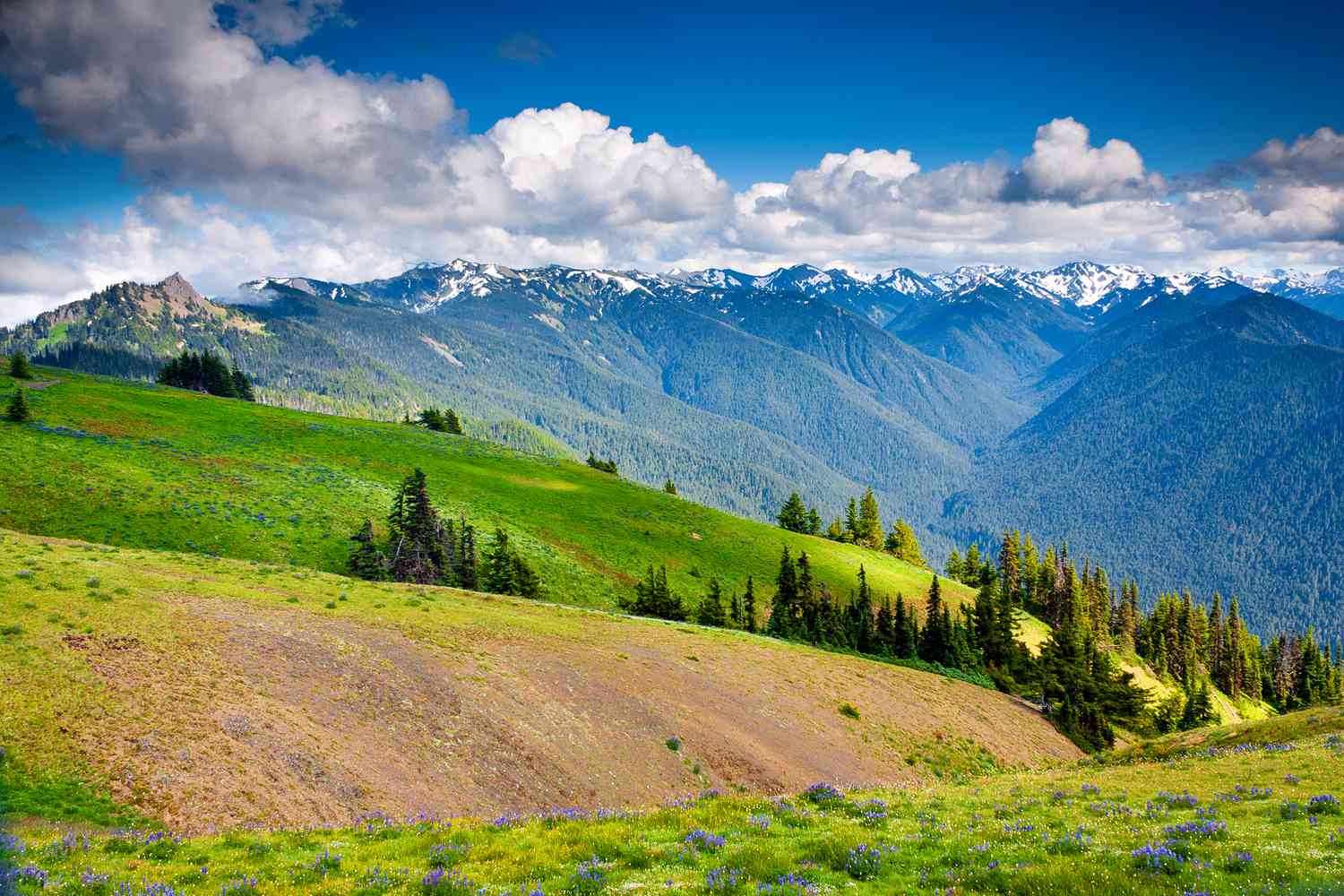
Benefits of moving to Washington State
Washington State is a place where nature is at arm’s length. It is one of the few states in the United States where you can find such diverse ecosystems in a relatively small area. Outdoor recreation is an integral part of life for locals. The excellent ecology, a large number of parks, forests and water bodies make Washington an ideal place to live for those who appreciate an active lifestyle and want to be close to nature.
Our moving company is ready to help you with your move to this wonderful region, taking care of all the worries associated with the transportation process. We will make your move to Washington State easy and comfortable.
Contact us in any way:
Telephone: (888) 282-6940


